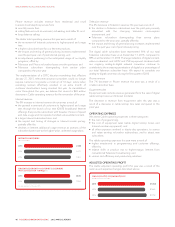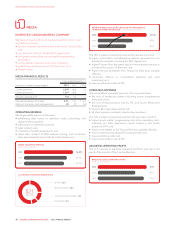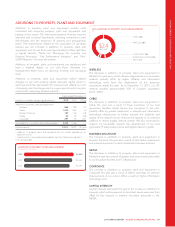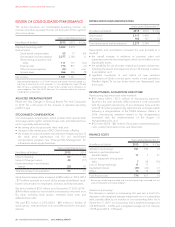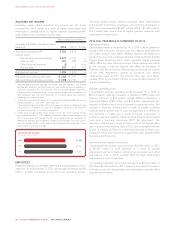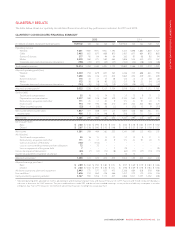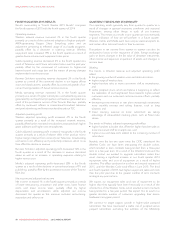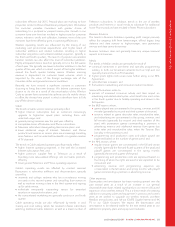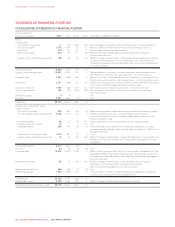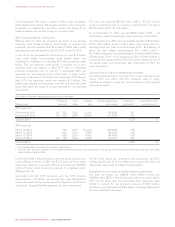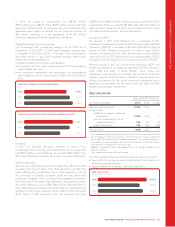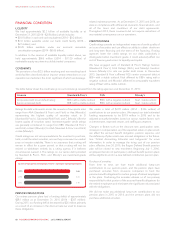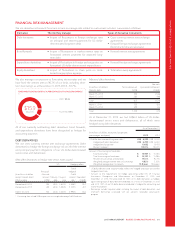Rogers 2015 Annual Report Download - page 56
Download and view the complete annual report
Please find page 56 of the 2015 Rogers annual report below. You can navigate through the pages in the report by either clicking on the pages listed below, or by using the keyword search tool below to find specific information within the annual report.MANAGEMENT’S DISCUSSION AND ANALYSIS
FOURTH QUARTER 2015 RESULTS
Results commentary in “Fourth Quarter 2015 Results” compares
the fourth quarter of 2015 with the fourth quarter of 2014.
Operating revenue
Wireless network revenue increased 3% in the fourth quarter
primarily as a result of the continued adoption of higher-postpaid-
ARPA-generating Rogers Share Everything plans and an
adjustment pertaining to reflected usage of our loyalty programs,
partially offset by a decrease in roaming revenue. Wireless
equipment sales increased 19% in the fourth quarter as a result of
greater device volumes and equipment sales prices.
Cable operating revenue decreased 2% in the fourth quarter as a
result of Television and Phone subscriber losses over the past year,
partially offset by the movement of customers to higher-end
Internet speed and usage tiers and the impact of pricing changes
implemented over the past year.
Business Solutions operating revenue decreased 2% in the fourth
quarter as a result of the continued decline in our legacy off-net
voice and data business, partially offset by continued growth of on-
net and next generation IP-based services revenue.
Media operating revenue increased 3% in the fourth quarter
primarily as a result of higher subscription and advertising revenue
generated by our Sportsnet properties and revenue generated as a
result of the postseason success of the Toronto Blue Jays, partially
offset by continued softness in conventional broadcast television
and print advertising and lower merchandise sales at TSC.
Adjusted operating profit
Wireless adjusted operating profit increased 4% in the fourth
quarter primarily as a result of the increased network revenue,
partially offset by the increased net subsidies associated with higher
gross additions and higher cost smartphones.
Cable adjusted operating profit increased marginally in the fourth
quarter primarily as a result of relative shifts in the product mix to
higher-margin Internet from conventional Television broadcasting
and various cost efficiency and productivity initiatives, which more
than offset the decline in revenue.
Business Solution’s adjusted operating profit decreased 12% in the
fourth quarter as a result of the decrease in revenue described
above as well as an increase in operating expenses relating to
higher service costs.
Media’s adjusted operating profit decreased 28% in the fourth
quarter as a result of the declines in conventional areas of TV and
publishing, partially offset by the postseason success of the Toronto
Blue Jays.
Net income and adjusted net income
Net income increased 1% in the fourth quarter primarily as a result
of lower restructuring, acquisition and other costs, lower finance
costs, and lower income taxes, partially offset by higher
depreciation and amortization, while adjusted net income
decreased this quarter as this measure excludes restructuring,
acquisition and other costs.
QUARTERLY TRENDS AND SEASONALITY
Our operating results generally vary from quarter to quarter as a
result of changes in general economic conditions and seasonal
fluctuations, among other things, in each of our business
segments. This means our results in one quarter are not necessarily
a good indication of how we will perform in a future quarter.
Wireless, Cable, and Media each have unique seasonal aspects to,
and certain other historical trends in, their businesses.
Fluctuations in net income from quarter to quarter can also be
attributed to losses on the repayment of debt, foreign exchange
gains or losses, changes in the fair value of derivative instruments,
other income and expenses, impairment of assets, and changes in
income taxes.
Wireless
The trends in Wireless revenue and adjusted operating profit
reflect:
• the growing number of wireless voice and data subscribers;
• higher usage of wireless data;
• higher handset sales as more consumers shift to smartphones;
and
• stable postpaid churn, which we believe is beginning to reflect
the realization of our heightened focus towards higher valued
customers and our enhanced customer service efforts; partially
offset by
• decreasing voice revenue as rate plans increasingly incorporate
more monthly minutes and calling features, such as long
distance; and
• lower roaming revenue as more subscribers are taking
advantage of value-added roaming plans, such as Roam Like
Home.
The trends in Wireless adjusted operating profit reflect:
• higher handset subsidies that offset the higher handset sales as
more consumers shift to smartphones; and
• higher voice and data costs related to the increasing number of
subscribers.
Notably, over the last two years since the CRTC introduced the
Wireless Code, we have been anticipating the double cohort,
which resulted in term contracts being limited from a three-year
term to a two-year term. As a result of the Wireless Code and the
double cohort, we worked to upgrade subscribers earlier than
usual, causing a significant increase in our fourth quarter 2014
equipment sales and cost of equipment as a result of higher
subsidies. This effect continued in our first and second quarters of
2015, until the Wireless Code took effect in June 2015. The third
and fourth quarters of 2015 had higher equipment sales and costs
than the prior year due to the greater number of term contracts
ending at any point in time.
We expect our equipment sales and cost of equipment to be
higher than they typically have been historically as a result of the
introduction of the Wireless Code, which resulted in term contracts
being limited to a two-year period. We expect this to result in a
greater absolute number of customers upgrading their device
hardware in any given period.
We continue to target organic growth in higher-value postpaid
subscribers. We have maintained a stable mix of postpaid versus
prepaid subscribers excluding the addition of the Mobilicity
54 ROGERS COMMUNICATIONS INC. 2015 ANNUAL REPORT




